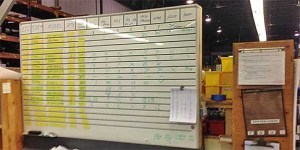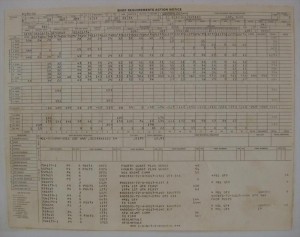These articles are portions of a lecture presented to APICS by our friend Gene Caiola.
How did we get here?
Manufacturers have long contended with trying to deliver on-time. Meeting delivery commitments is one of the most primary characteristics of a good supplier. Not meeting these commitments can result in poor supplier ratings that may ultimately cause a supplier to be dropped from their customer’s supply chain.
But how do manufacturers schedule their work in a typical manufacturing plant? For the average manufacturer there are typically 300 to 1000 work orders on the floor at any time. It’s a sizable task to keep that level of work flowing smoothly.
Many have adopted the age old tried and true “Scheduling Board”. The main board can be found somewhere near the production planner’s office and other boards for a specific work center will be posted near a machine. These boards are updated manually by people that either release the new jobs or work jobs in process. A well maintained board will show you where a job is and when it is expected to be worked on. If you see these on a shop floor then you have found a manufacturer who has either never tried using a computer system to schedule or DID try and gave up.

But why would scheduling using a computer be so difficult? To answer that we have to take a look at how scheduling evolved on the shop floor. We even have to go backwards a little bit more and understand how Material Requirements Planning (MRP) got the scheduling ball rolling.
The Early Days of Manufacturing Systems In the early 1960’s MRP was introduced to manufacturers as a means to determine what products to make and what materials were needed to make those products. The Bill of Material (BOM) became a common structure in manufacturing that could be processed by a computer system. MRP would yield “Work Orders” and “Purchase Orders”. A Work Order told the manufacturer what to make and what date to make it by and a Purchase Order told them what materials to buy.

It became common to have an MRP type system create hundreds of Work Orders that were “pushed” to the floor for production. But the reality on the shop floor is that there are only so many people and only so many machines available to make product. MRP did not solve this problem. Our BOM data needed some additional data if we were to work on this problem. What was needed was a “Routing”. A routing identified each and every step of production (a step is called an operation) and also indicated the amount of time needed to do that step. Now that every work order had a routing you can imagine that hundreds of operations needed to be completed on the shop floor.
The back story to what was happening in these early manufacturing systems was to be found in the amount of computing power available during the 1960’s and 1970’s. It wasn’t much and that was the first constraint on these scheduling systems. Computing power was available only through the use of mainframes – very powerful and very expensive machines. Any manufacturing system back then could only hope to process a BOM never mind every operation on a routing. Because of this, the design of manufacturing systems came as incremental steps forward based on the pace of the availability of cheaper and more powerful computers. The first step in this direction was the advent of “Rough Cut Capacity” planning. A simplified version of a routing was processed and yielded the total amount of capacity that was needed over a period of time. This helped a bit with planning for capacity but did little to keep the jobs flowing on the shop floor in a way that ensured that delivery dates were met.
Enter Finite Scheduling
As the 1980’s and 1990’s brought minicomputers and the personal computers, the cost of computer processing power went down dramatically and the complexity of scheduling models went up…
Thus the world entered the next phase of resource management. How did Finite Scheduling change the industry? In our next blog installment “MRP Trouble, Enter Finite Scheduing” we will be breaking it down.
